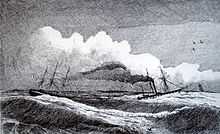Luxor Obelisk

.jpg)

The Luxor Obelisk (French: Obélisque de Louxor) is a 23 metre (75 ft) high Egyptian obelisk standing at the center of the Place de la Concorde in Paris, France. It was originally located at the entrance to Luxor Temple, in Egypt.
History
Two 3,300-year-old twin obelisks once marked the entrance to the Luxor Temple. Muhammad Ali Pasha, the Wāli and self-proclaimed Khedive of Egypt, offered the two obelisks to France as a gift in 1829.

In August 1832, the French paddle ship Sphinx sailed to Alexandria to rendezvous there with the barge Louqsor, which was to load the Luxor Obelisk and bring it to Paris. Sphinx then towed Louqsor back to France. The ships departed on 1 April 1833 and reached Toulon on 10 May. The ships arrived at Cherbourg on 12 August 1833.
The first obelisk arrived in Paris on December 21, 1833. Three years later, on October 25, 1836, King Louis-Philippe of France had it placed in the center of Place de la Concorde.
Features
The obelisk, a yellow granite column, rises 23 metres (75 ft) high, including the base, and weighs over 250 metric tons (280 short tons). It is decorated with hieroglyphs exalting the reign of the king Ramses II.
Given the technical limitations of the day, transporting it was no easy feat: on the pedestal are drawn diagrams explaining the complex machinery that were used for the transportation. The obelisk is flanked on both sides by fountains constructed at the time of its erection on the Place.
Missing its original pyramidion (believed stolen in the 6th century BC), the government of France added a gold-leafed pyramid cap to the top of the obelisk in 1998.
Modern events
- Early morning on December 1, 1993, the French AIDS fighting society Act Up Paris carried out a fast and unwarned commando-style operation. A giant pink condom was unrolled over the whole monument to mark World AIDS Day.[1]
- Without warning, in 1998 and 2000 French urban climber Alain "Spiderman" Robert, using only his bare hands and climbing shoes on his feet and with no safety devices, scaled the obelisk all the way to the top.
See also
References
- ↑ One participant recounts (in French) her experience, and a photo is shown at
External links
| Wikimedia Commons has media related to Luxor Obelisk. |
Coordinates: 48°51′56″N 2°19′16″E / 48.86556°N 2.32111°E